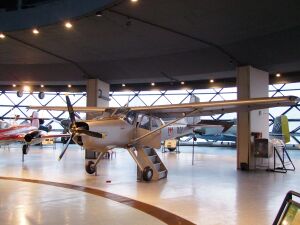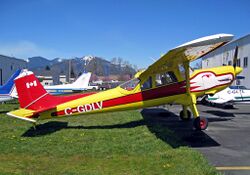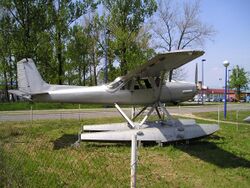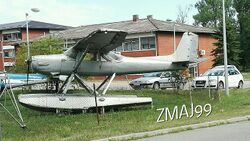Engineering:Utva 66
| Utva-66 | |
|---|---|

| |
| Utva-66 on display in the Museum of Aviation | |
| Role | Military Training Aircraft/General Aviation Aircraft |
| Manufacturer | UTVA |
| Designer | UTVA |
| First flight | 1966 |
| Status | Retired |
| Number built | 130 |
The UTVA-66 is a STOL aircraft, which was produced in the former Yugoslavia. It was developed from the UTVA-60 and first flew 1966.
Description
The aircraft was built for landing on unprepared fields and its STOL characteristics include leading edge fixed slats, flaps and drooping ailerons. The cockpit is equipped with dual flight controls. The right front and rear seats in the older version of the aircraft were able to accommodate two stretchers. The aircraft had floats to land on water, but they could have been exchanged for snow skis.
Operational usage
130 UTVA-66 aircraft were manufactured. The last operational aircraft were withdrawn from military service in 1999.
Subsequently, a number were sold to Canada and the United States of America where they were converted for civilian use as rugged utility aircraft.
Variants
- 66AM air ambulance
- 66H
- 66V
- 66 Super STOL
- 66A never entered military service
Former military operators
 Bosnia and Herzegovina
Bosnia and Herzegovina
 Croatia
Croatia
 Macedonia
Macedonia
 Republika Srpska
Republika Srpska
- Republika Srpska Air Force
- 92nd Light Multi role Aircraft Squadron
 Yugoslavia
Yugoslavia
- Yugoslav Air Force
- 461st Light Combat Aviation Squadron (1977–1988)
- 462nd Light Combat Aviation Squadron (1977–1981)
- 252nd Fighter-Bomber Aviation Squadron (1981–1992)
- Letalski center Maribor (Civil operator) (1989-2003)
Aircraft on display
- Serbia
- Museum of Aviation (Belgrade) in Belgrade
A number of Utva 66 including Utva 66H are on display. [1]
Specifications (Utva 66)
Data from Jane's All the World's Aircraft 1971–72.[1]
General characteristics
- Crew: 1
- Capacity:
- 3 passengers or
- 2 stretchers
- Length: 8.38 m (27 ft 6 in)
- Wingspan: 3.47 m (11.40 ft)
- Height: 3.20 m (10 ft 6 in)
- Wing area: 18.08 m2 (194.6 sq ft)
- Airfoil: NACA 4412 (modified)
- Empty weight: 1,250 kg (2,756 lb)
- Max takeoff weight: 1,814 kg (3,999 lb)
- Fuel capacity: 250 L (55 imp gal; 66 US gal)
- Powerplant: 1 × Lycoming GSO-480-B1J6 air-cooled flat-six engine, 200 kW (270 hp) [2]
Performance
- Maximum speed: 250 km/h (160 mph, 130 kn) at optimum height
- Cruise speed: 230 km/h (140 mph, 120 kn) (max cruise)
- Stall speed: 80 km/h (50 mph, 43 kn)
- Never exceed speed: 320 km/h (200 mph, 170 kn)
- Range: 750 km (470 mi, 400 nmi)
- Service ceiling: 6,700 m (22,000 ft)
- Rate of climb: 4.50 m/s (885 ft/min)
- Takeoff run to 15 m (50 ft}: 352 m (1,155 ft)
- Landing run from 15 m (50 ft): 181 m (594 ft)
See also
Aircraft of comparable role, configuration and era
References
- ↑ Taylor 1971, pp. 472–473
- ↑ Fulton 1973, p. 104
- Fulton, Ken (19 July 1973). "Piston Engine Survey". Flight International 104 (3358): 98–106. https://www.flightglobal.com/pdfarchive/view/1973/1973%20-%201953.html.
- Taylor, John W. R., ed (1971). Jane's All The World's Aircraft 1971-72. London: Sampson Low. ISBN 0-354-00094-2.
External links
 |




